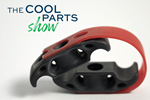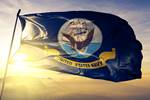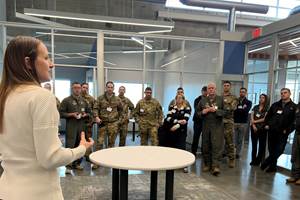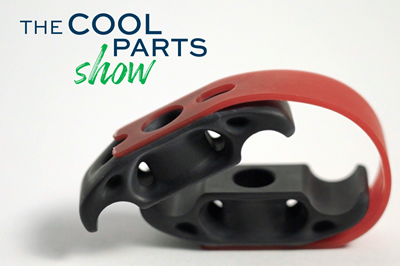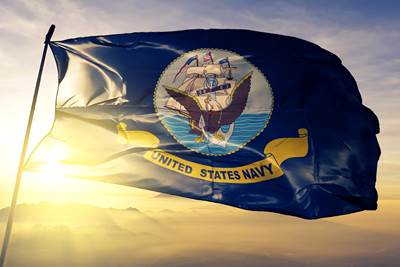For Coast Guard, AM Adoption Begins With “MacGyver-ish” Crew Members Who Are Using 3D Printing Already
AM suits the Coast Guard’s culture of shipboard problem-solving, says Surface Fleet AM lead. Here is how 3D printers on ships promise to deliver not just substantial cost savings but also an aid to crew capabilities and morale.
An adapter made via 3D printing, which allowed a fuse that was on-hand to complete a critical circuit the fuse otherwise did not fit, enabled a U.S. Coast Guard cutter in the Caribbean to continue operating rather than wait for a replacement part.

This simple part kept a U.S. Coast Guard cutter operational: the CGC Forward, pictured below. The fuse adapter allowed a critical circuit to be completed by a fuse that otherwise did not fit. All photos courtesy of the Coast Guard.
This win by the ship’s crew, using additive manufacturing, saved hundreds of thousands of dollars that would have been lost from the ship being temporarily out of commission. The one wrinkle, says Coast Guard Lieutenant Commander Andrew Armstrong, is that the 3D printer was not officially part of the shipboard equipment. Instead, a crew member had successfully persuaded his superiors that the ship should buy a small 3D printer. That same crew member then used his own CAD software to design 3D printed components. AM adoption is advancing in the Coast Guard, says Armstrong, and one of the tailwinds is the extent to which 3D printing is already quietly being used, whether it has been officially adopted or not.
Armstrong, National Industrial Enterprise Branch Chief for the U.S. Coast Guard, stationed in New Orleans at the time I spoke with him but now in Norfolk, Virginia, is also the Additive Manufacturing Lead for the Coast Guard Surface Fleet. The latter role is a volunteer position. An effort to develop, organize and institutionalize AM for replacement components on Coast Guard ships is entirely volunteer — “everybody is doing this on top of their day jobs,” he says — but that grassroots effort has won official notice and support to the extent that Armstrong expects a pilot program to begin soon which will place one of two polymer-deposition-style 3D printers (either a Markforged Onyx Pro or an UltiMaker S5) onto seven Coast Guard ships for initial evaluation.

The term “cutter” describes a Coast Guard vessel 65 feet or greater in length, and traditionally the term refers to ships directed toward enforcement activity such as patrolling territorial waters. Cutters such as the CGC Forward previously have not been officially outfitted with 3D printing, but have employed it nevertheless.
He says gaining acceptance for components produced this way, via 3D printing onboard the ship, is the most difficult part of AM adoption. 3D printing a replacement component is so fast, and generally so cheap, that it can seem like a slapdash or inadequate solution. And in some cases, it might be this. The safety and effectiveness of the 3D printed part as a replacement for an original part has to be proven, and this validation proceeds more slowly than the speed at which parts can be made.
Fortunately, the Coast Guard is not the first branch of the armed forces to go down this path. Armstrong says, “One of the advantages of being later: We looked at everything the Navy had done. We looked at their documents and reworked them for our surface fleet.” This was part of an ongoing consultation between the Coast Guard’s AM champions and the AM leaders in other military branches.
“We have been able to partner with various DOD entities, and they tipped us off to the things that ate their lunch,” he says. “The best advice they gave us was this: Write your policy first, then invest in equipment.”
The technology is ready now, he says, and that is why 3D printing is already put to use in the Coast Guard. However, policy development is what will allow equipment choices to be standardized, and what will allow additive manufacturing to become standard practice aboard Coast Guard ships.
Opportunities and Cautions for Additive

Armstrong (left) discusses additive manufacturing applications with Vice Admiral (now retired) Paul Thomas, who was then Deputy Commandant for Mission Support.
On land, Armstrong is already seeing AM used routinely. The resources at the New Orleans base include 3D printers from Fusion3 and Stratasys along with the previously mentioned Markforged and UltiMaker machines. They are used for tooling and training aids. An example of the former is 3D printed dams used in place of plywood carpentry to hold epoxy grouting for engine mountings. An example of the latter is a series of around 160 functional replicas of systems such as a fire suppression activation assembly and many different valve types, all for use in training. The 3D printed dams save an entire day from what had previously been a five-day engine install process, and the training aids expand access to hardware for training without having to consume the real components. However, having 3D printers onboard Coast Guard vessels is potentially a much bigger win that will save considerably more than these successes.
How much AM can save the Coast Guard as a solution for replacement parts is hard to calculate, Armstrong says, because the costs of not having a needed part at sea are so extensive. His analysis is worth considering even for manufacturers working far from shipboard, far from the shore, far from any military application, because the kinds of losses and opportunity costs he sees also apply to service part needs in a shop or plant, as well as to supply chain shortfalls.
The case of the cutter in the Caribbean and its fuse adapter is extreme, but it illustrates how lost time is the greatest expense. According to Armstrong’s analysis (see the sidebar on this page), the impact of a $900 3D printer producing the equivalent of a $2 hardware item was a savings to the Coast Guard of about $850,000.
Yet here is the valid counterargument: What is the potential cost or consequence if that part fails? The Coast Guard includes “a lot of folks who have been doing maritime engineering for 30 years before AM was involved,” Armstrong says, and part of what that experience reinforces is how interconnected and inter-reliant ship hardware components are. What effects will a failing component have system-wide, and could any of those effects imperil the safety of a crew member? A known component that is manufactured in the known way might be difficult or expensive to obtain, but its reliability is established and proven.

Some of the 3D printers used routinely at the New Orleans base where Armstrong works. The two smaller ones on the end, from Markforged (left) and UltiMaker (right), are the same models that will be installed on Coast Guard ships as part of a pilot program. (Yes, the Forward is one of the ships getting a new printer through this program.)
Armstrong says the response to this concern involves more than testing or validating individual parts. It requires an ongoing framework for reliably evaluating and assuring the fitness of a 3D printed part to replace an existing part, combined with allowing the culture to accept and trust in that framework. Again, the Navy’s existing work is valuable here. That framework addresses risk assessment and criticality assessment, which includes, respectively, the potential consequence to crew members and to operation of the vessel if the new part fails. One priority for the Coast Guard is also to find the most flexible technical data package it can that will still reliably produce an acceptable part. The realities of printing on a cutter require this.

3D printed dams (black) speed and simplify the use of liquid chocking compound (orange). The use of these dams for shipboard engine mounting applications is now patent pending.
“We are trying not to lock every parameter in because printing here on base is going to be different than on a ship. If they need to tweak something, we don't want them to have an unqualified part just because they had to raise their nozzle temperature 5 degrees,” he says.
That said, Armstrong notes the Coast Guard surface fleet tends to be less risk averse than other organizations using AM, including other parts of the military. The surface fleet is distinct from the aircraft division, another vital part of the Coast Guard. The maritime work is freeing in terms of technology adoption because “boats don’t fall out of the sky,” he says. In addition, he notes the surface fleet is comprised of “well-maintained ships that have been around for a while,” and the culture of the Coast Guard encourages creative problem solving to keep them operating. One of the potential benefits of 3D printing is the role it will be able to play in amplifying and leveraging that culture.
Force Multiplier for Field Operations
Armstrong, now 14 years with the Coast Guard, has seen this in his own shipboard experience. “I have done some very MacGyver-ish things, and watched my shipmates do the same, to get the mission done,” he says. “Everything from making our own fasteners, to filing down an old plexiglass sheet into a fin so a pump will spin. This is commonplace in the Coast Guard, I think it is commonplace in field operations everywhere, and I see the potential empowerment, the potential to be a force multiplier, that 3D printing brings.”
To be waiting or dependent, to be at anchor until a part can come, is not just a loss in terms of the operating cost of the ship, but also a loss in terms of the morale and confidence of creative crew members. By contrast, the improved self-sufficiency from 3D printing makes the Coast Guard stronger not only because of what the ship can print, but because of the creative power this turns loose.
“I’ve been with guys and we worked to fix a problem until 1:00 a.m., without getting it, and then we wake up at 7:00 a.m. and some of them are like, ‘As soon as I got to my rack, I couldn’t sleep. I was thinking, what if it’s this? Or what if it’s this?’ They are just so excited to find the fixes, and giving them more tools to do that offers a huge morale potential that I hope we can tap into.”
Indeed, this advance will also open the way to retroactively benefiting from the creativity 3D printing has already made possible. There are perhaps 30 to 40 shipboard problems that have been solved through 3D printing, in some cases quietly. But the AM policy development led so far by over 3 years of volunteer effort has delivered this result: There is now a finalized approval process for AM parts.
“There is a lot of experience out there that is not being captured. Now that we have a part approval process, we are working to catch up and get solutions from the field into our system,” says Armstrong, who is now approaching ships’ crews about sharing their AM wins.
He says, “I tell them: No one is going to punish you. Just tell me what you’re printing and send me the files, so we can get them approved and others can use them as well.”
Related Content
The Cold Spray Solution to the Casting, Forging Supply Chains
Startup HAMR Industries performs additive manufacturing work at Neighborhood 91 that provides an alternative to traditional casting and forging. Success so far has led to redefining the limits of its additive equipment.
Read MoreAt General Atomics, Do Unmanned Aerial Systems Reveal the Future of Aircraft Manufacturing?
The maker of the Predator and SkyGuardian remote aircraft can implement additive manufacturing more rapidly and widely than the makers of other types of planes. The role of 3D printing in current and future UAS components hints at how far AM can go to save cost and time in aircraft production and design.
Read MoreHow a DOD-Funded Resilient Manufacturing Ecosystem (RME) Is Coming Together at Neighborhood 91
Pittsburgh’s additive manufacturing campus doubles as a test bed for a Department of Defense project aimed at developing a reproducible ecosystem for on-demand production of critical parts.
Read MoreThe Top 10 Additive Manufacturing Stories of 2024
Defense, space exploration, thermal management — these are some of the topics that captured the Additive Manufacturing audience’s interest in 2024. But there’s also an overarching theme: Don't wait for additive manufacturing to be perfect. Instead, leverage the applications perfect for AM.
Read MoreRead Next
3D Printed Replacement Clamp for an F-16 Aircraft: The Cool Parts Show #54
3D printing is a valuable addition to sustainment programs, but only if printed parts can be qualified as fast and flexibly as they can be made. In this episode of The Cool Parts Show, we look at the clamp that won the Air Force’s Approval Sprint Challenge designed to address this need.
Read MoreNavy Improves Readiness of USS Bataan With 3D Printing Capability
Crew of USS Bataan completed the first metal 3D part fabrication and replacement for a de-ballast air compressor in only five days using a permanently installed metal 3D printer, demonstrating the impact this technology can have on operational readiness.
Read MoreSpee3D’s Expeditionary Manufacturing Unit 3D Prints Large Metal Parts in the Field
The Expeditionary Manufacturing Unit enables users to replace metal parts in hours instead of days or weeks, thereby minimizing disruption and downtime.
Read More

